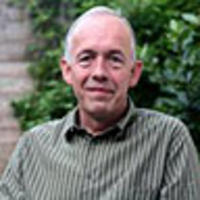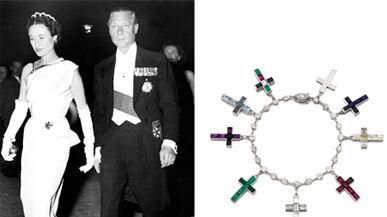A selection of the Duchess of Windsor’s jewels fetched $12.5 million at auction this week. Martyn Gregory, who produced a BBC film about the famous collection, recalls Mohamed Al-Fayed’s fascination with them.
This week’s sale of a selection of the Windsors’ historic jewels for $12.5 million at Sotheby’s in London was record breaking and the sums paid by the anonymous buyers were extraordinary. The 1952 onyx & diamond panther bracelet sold for $7,036,874, the highest ever paid for a bracelet or any Cartier at auction.
The intimate jewels, many of which were inscribed with personal messages between King Edward VIII and his American lover, Wallis Simpson, have long fascinated historians and collectors as they chronicle the couple’s forbidden love.
Gallery: The Duchess of Windsor’s Jewelry Collection

History documents the King abdicating in 1936 so he could marry Wallis Simpson, and the resulting royal scandal and constitutional meltdown. The jewels tell the intimate, personal side of their love story. They are inscribed in the couple’s secret WE (Wallis & Edward) personal messages code. They span the couple’s early days in the 1930s, when Edward ruled a third of the world as King of the British Empire and Wallis Simpson was a mere American divorcee, to their time in Palm Beach in the 1950s. By then, the former King and his wife were the Duke and Duchess of Windsor and living in exile, as they would for the rest of their days.
Following the death of the Duchess of Windsor in 1986, the jewels raised $50 million at auction in Geneva the following year. That remains a record for a sale of jewels belonging to a single owner—the Duchess of Windsor’s estate. Her will dictated that the proceeds went to the Pasteur Institute in Paris for its pioneering fight against AIDS.
This week’s sale to multiple buyers isn’t only the most recent chapter in the long history of the coveted jewels. It has also finally laid to rest former Harrods’ owner Mohamed Al-Fayed’s ambition to acquire what Sotheby’s David Bennett, who worked on both the 1987 & 2010 Windsor jewels auctions, described as “the most important” jewelry collection of the 20th century.
After the Duchess of Windsor died in 1986, Fayed had swiftly acquired the lease on the Windsors’ Paris home in the Bois de Bologne from the then mayor of Paris, Jacques Chirac. He has rented it ever since. To his chagrin, the jewels were not included, so Fayed tried desperately to buy them to complete his collection of the Windsors’ Paris memorabilia. He already owned the Paris Ritz in the Place Vendome where the suite the couple spent time in had been named the “Windsor suite.” At the time, Fayed was laboring under the misapprehension that the Royal family would be impressed by his restoration of the villa Windsor. He appeared to think that reminding the British royal family of the darkest chapter in their 20th century history might endear him to the Queen and to the British establishment. The British passport the Egyptian was then seeking eludes him to this day.
He offered a paltry $9.37 million (£6 million) for the Windsor jewels. The executor of the duchess’ estate, the late Maitre Blum, was unimpressed. The jewels went to auction in Geneva, as the duchess’ will instructed them to.
Fayed told me he was incandescent over the 1987 auction. At the time, I was with him in Paris producing a film about the Windsor jewels for the BBC1 ( The Uncrowned Jewels). Fayed was keen to appear and promote his multi-million dollar restoration of the villa Windsor. The Egyptian businessman chose to blame the elderly Jewish lawyer for thwarting his ambitious purchase of the jewels, rather than the Duchess whose will decreed that the jewels be sold for charity.
Fayed afforded us complete access to the villa Windsor while Sotheby’s granted us pre-auction access to film the jewels in a Geneva vault protected by armed guards. The enduring fascination that the British public had for the Windsor story was reflected in the 12.9 million viewers who watched The Uncrowned Jewels—an extraordinary audience for a single documentary.
One day while arriving to film in the villa, we were astonished to find a representative of the Daily Mail measuring up the Duke’s bedroom—a shocking discovery as this was supposed to be a BBC world exclusive. He told the program’s presenter & BBC royal correspondent, Michael Cole, and myself that the Mail had Fayed’s permission to ship the Duke’s bedroom to Olympia in Earls Court for the Ideal Home exhibition the following month.
We phoned Fayed from the kitchen, and Michael tried to persuade him that this was not a good idea. I vividly remember his key argument: ‘What do you think her majesty would think of her late uncle’s bed pitched up amongst the hoi polloi and their discarded burger wrappings and Coke cans in Earl’s Court?”
I did not hear Fayed’s response, but the Daily Mail disappeared and the former King’s bedroom stayed in France.
Currently, there is no mention of the Windsor jewels on Fayed’s site and it’s unclear if he made a last-ditch effort to own some of the gems. Given his history with the royal family, it wouldn’t be surprising if he put in a bid. Owning an extravagant and sentimental keepsake from one of history’s most romantic couples certainly would be the crown jewel in Fayed’s collection.
Plus: Check out Art Beast, for galleries, interviews with artists, and photos from the hottest parties.
Martyn Gregory is a London based TV producer & reporter who has won Amnesty International & Royal Television Society awards for his investigative work on human rights. A leading international authority on the Paris crash following his 1998 film Diana-The Accident for Channel 4, Gregory’s book Diana The Last Days became a bestseller. Some of his TV work on Diana’s death can be found here.






